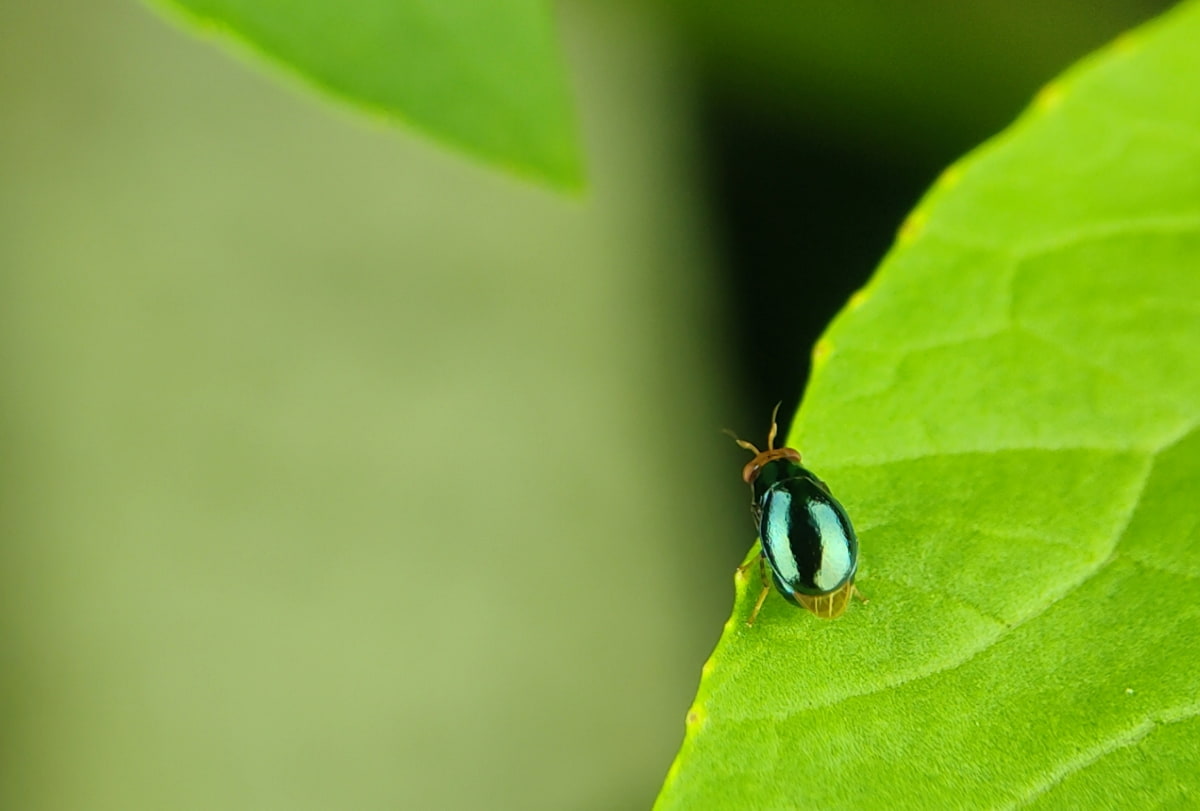Flea beetles, minute but formidable pests, pose a significant threat to vegetable gardens. Their ability to jump like fleas and their voracious appetite for the foliage and roots of numerous vegetable plants make them gardener’s adversaries. Their impact ranges from cosmetic damage to considerable harm, impairing plant health and potentially leading to plant death.

Effectively managing these tiny pests involves an integrated approach incorporating preventive measures, natural and chemical control methods, and post-infestation treatment strategies. Here we learn about managing flea beetles in your vegetable garden, featuring methods such as natural repellents, coffee grounds, and soap water, and an overview of appropriate insecticides.
Management of Flea Beetles in the Vegetable Garden
Understanding the Flea Beetle Damage in Your Vegetable Garden
Flea beetles are small jumping pests aptly named for resembling fleas. Their size, ranging from 1/16th to 1/8th of an inch, belies their potential for harm to vegetable gardens. The adult flea beetle can defoliate and damage plants by creating shot-hole-like feeding marks on the foliage, while the larvae can cause harm to plant roots and tubers.
Different species of flea beetles prefer different host plants, posing threats to a wide array of vegetables, including tomatoes, eggplants, peppers, and Brassica family members like broccoli, cabbage, and radishes. The extent of damage can vary, ranging from cosmetic to severe impairment of plant health and even death in some instances.
Preventive Measures: Forearming Your Garden Against Flea Beetles
Understanding the flea beetle life cycle is essential for successful preventive measures. Adult flea beetles overwinter in the soil or plant debris and emerge during warm spring days to feed and lay eggs at the base of host plants. In a week or two, larvae hatch and feed on roots, pupating in the soil and emerging as adults. The complete life span spans approximately one month, with the potential for multiple generations to emerge within a single growth cycle.
Maintaining a healthy, diverse garden is a fundamental step in preventing flea beetle infestation. Robust plants are more likely to withstand damage, and diversity in planting can help disrupt the lifecycle of the beetles. Intercropping susceptible plants with less preferred ones can deter the beetles from laying eggs. Crop rotation can also break the flea beetle lifecycle as the beetles return to previously infested areas. Maintaining good sanitation practices by removing plant debris can limit the number of overwintering adult beetles.
How to Get Rid of Flea Beetles Naturally: Leveraging Biological Controls
Biological control of flea beetles is an environmentally friendly, sustainable approach that complements preventive measures. Ladybugs, lacewings, and predatory ground beetles are advantageous insects that regulate flea beetle populations. These beneficial insects can be encouraged by planting native flowers or herbs that provide them with nectar and pollen. Additionally, nematodes, microscopic worms, can be introduced into the soil to prey on flea beetle larvae. Parasitic wasps and certain fungi like Beauveria bassiana can also be employed to keep the beetle population in check.
The Power of Organic Matter: Coffee Grounds for Flea Beetles
Organic matter, including coffee grounds, can deter flea beetles. The rough texture of coffee grounds can be uncomfortable for the beetles, and the caffeine can harm them. Coffee grounds can be lightly spread around the base of plants to create a barrier. Additionally, they contribute to soil enrichment by adding organic material and nutrients.
In case you missed it: How to Grow Lucky Bamboo in Soil: A Guide for Planting to Care

DIY Solutions: Will Soap Water Kill Flea Beetles?
Yes, a simple homemade soap and water solution can be quite effective in combating flea beetles. A soap solution disrupts the outer layer of the insect’s body, leading to dehydration and death. To prepare the solution, mix a small quantity of dish soap with water and administer it as a spray to the relevant plants, ensuring comprehensive coverage of both sides of the leaves. Use caution to prevent potential harm to the plants by controlling the concentration of soap. Before applying the solution extensively, conduct a test on a small section of the plant and carefully monitor for any adverse responses.
Flea Beetle Control Insecticides: Chemical Means of Control
In the face of a severe flea beetle infestation, it may be necessary to resort to insecticides. Various organic and synthetic pesticides are accessible for effectively managing flea beetles. These include neem oil, pyrethrins, spinosad, and other botanical insecticides. These insecticides act on contact, so thorough application to all plant surfaces is necessary for effectiveness.
Neem oil, derived from neem tree seeds, functions by interrupting beetles’ life cycle and inhibiting their feeding behavior. Pyrethrins are natural insecticides derived from certain chrysanthemum flowers and act quickly on contact but degrade rapidly, minimizing their environmental impact.
Spinosad is a soil-dwelling bacterium that acts on the nervous system of insects, leading to their death. Nonetheless, the application of these insecticides can have an impact on beneficial insects that are not the intended target. Thus, their utilization should be cautiously exercised, preferably during the early morning or late evening when pollinators exhibit reduced activity levels.
Synthetic insecticides include carbaryl, permethrin, and imidacloprid. These potent chemical agents can control flea beetles but pose more considerable risks to the environment and non-target organisms. Additionally, insecticides should be used as part of an integrated pest management (IPM) strategy and not as the sole control method. While applying any insecticide, always follow the manufacturer’s instructions and safety precautions. Wear appropriate personal protective equipment and avoid spray drift to non-target areas.
Treatment Post-Infestation: Restoring Health to Your Garden
Once an infestation has occurred, rapid action is necessary to minimize damage and restore the health of your vegetable garden. The first step is to remove severely infested plants to prevent the spread of the beetles. Following this, biological controls and insecticides can be employed, as previously discussed.
In case you missed it: 10 Causes of a Dying Rosemary Plant and How to Fix it?

Consider introducing resistant varieties of plants if a particular species in your garden seems highly susceptible to flea beetle damage. Some plant varieties are naturally more resistant to pests and can be a valuable addition to your garden, providing an inbuilt defense mechanism against these voracious beetles.
Conclusion
Effectively managing flea beetles in your vegetable garden necessitates a holistic approach encompassing preventive measures, control techniques, and treatment strategies. By gaining insights into the life cycle of flea beetles and leveraging both natural and chemical control methods, you can equip yourself with the essential resources to address an infestation successfully.
- Ultimate Guide to Ossabaw Island Hog: Breeding, Raising, Diet, and Care
- Ultimate Guide to Juliana Pig: Raising Facts, Size, Diet, Care, and Lifespan
- Raising Lleyn Sheep: Disadvantages, Price, Uses, Characteristics, and Care
- Ultimate Guide to Meishan Pig: Breed Facts, Breeding, Raising, and Care
- Ultimate Guide to Teacup Pigs: Raising, Diet, Lifespan, Cost, and Care
- Guide to Raising Poll Dorset Sheep: Facts, Profile, Characteristics, Uses, and Care
- Ultimate Guide to Bighorn Sheep: Characteristics, Diet, Lifespan, Breeding, and Lifecycle
- Ultimate Guide to Raising Katahdin Sheep: Farming Facts, Breed Profile, Uses, and Care
- Ultimate Guide to Raising Oreo Cows: Belted Galloways Farming Facts, Profile, Uses, and Care